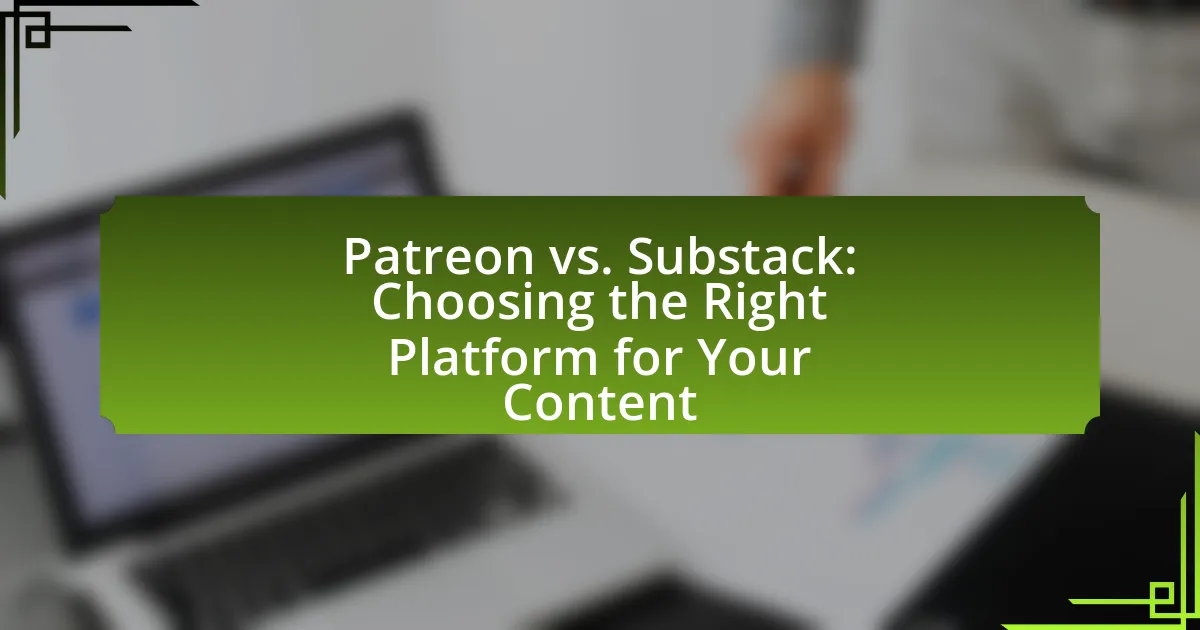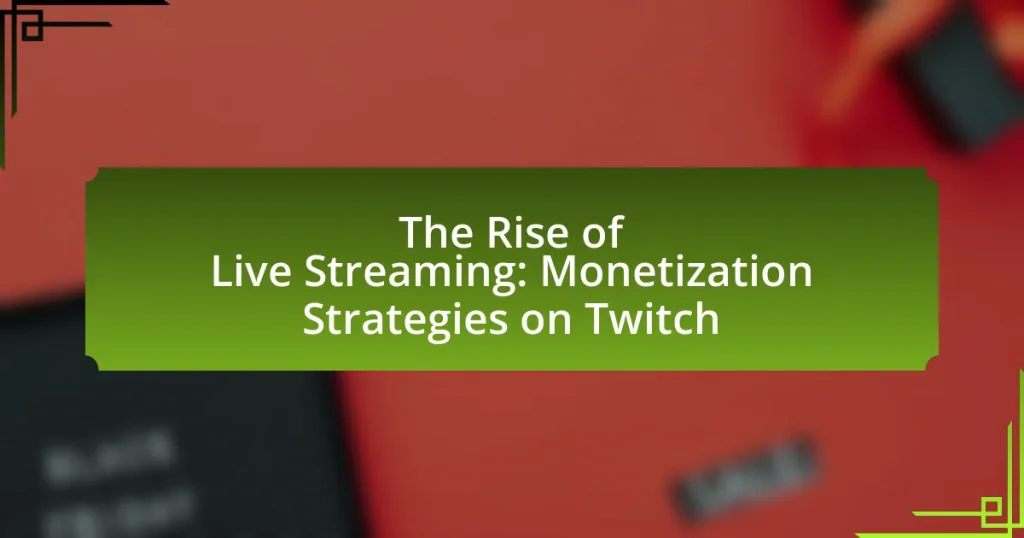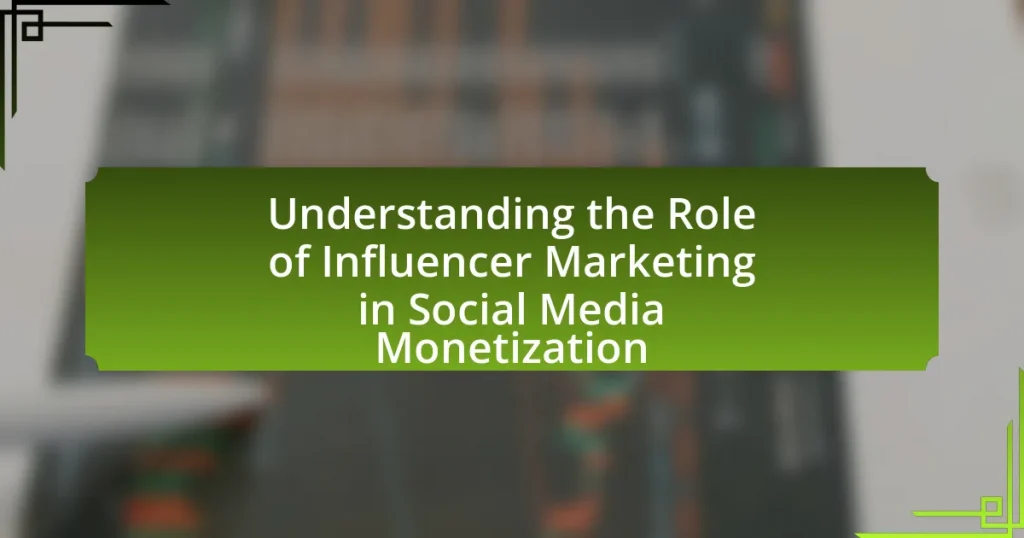The article examines the key differences between Patreon and Substack, two platforms designed for content creators but serving distinct purposes. Patreon focuses on membership-based funding with tiered subscriptions that offer exclusive content and community engagement, making it suitable for creators of diverse content types like videos and podcasts. In contrast, Substack is a newsletter platform that allows writers to monetize their email subscriptions, primarily catering to those who produce long-form written content. The article further explores how each platform supports different types of creators, their monetization models, audience engagement strategies, and the advantages and disadvantages of using each service, ultimately guiding creators in choosing the right platform based on their content goals and audience preferences.
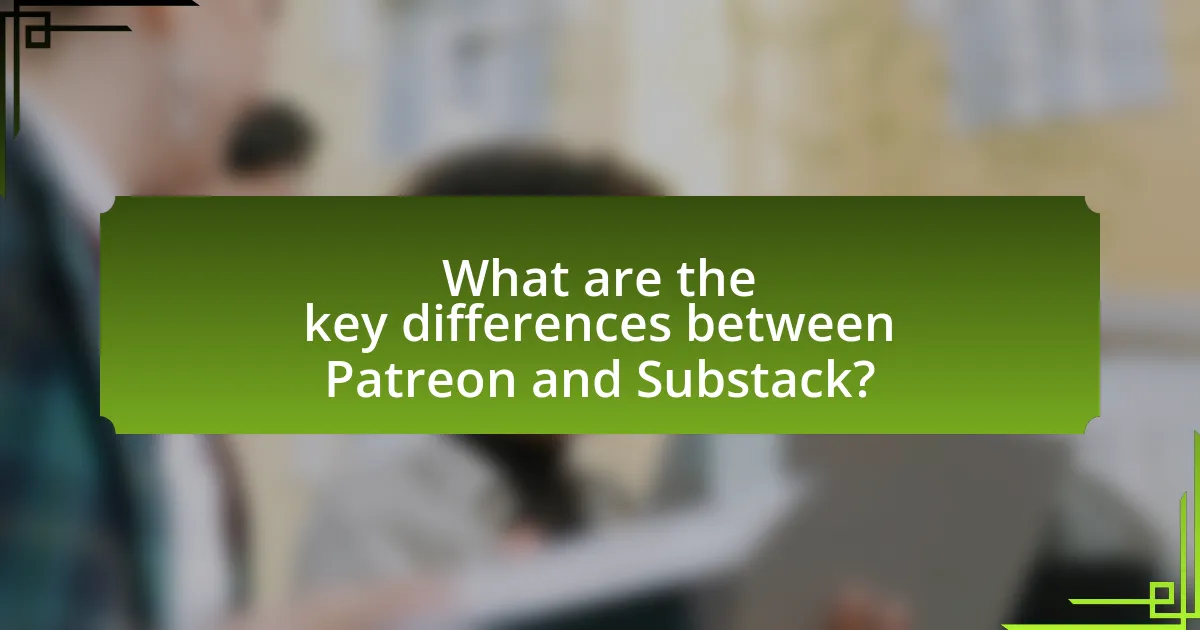
What are the key differences between Patreon and Substack?
Patreon and Substack serve different purposes for content creators. Patreon focuses on membership-based funding, allowing creators to offer various tiers of subscription with exclusive content, community engagement, and rewards. In contrast, Substack is primarily a newsletter platform that enables writers to monetize their email subscriptions, focusing on delivering written content directly to subscribers’ inboxes.
The key difference lies in their monetization models: Patreon emphasizes tiered memberships and community interaction, while Substack centers on straightforward subscription-based access to written content. This distinction is evident as Patreon supports diverse content types, including videos and podcasts, whereas Substack is tailored for text-based newsletters.
How do Patreon and Substack cater to different types of content creators?
Patreon and Substack cater to different types of content creators by focusing on distinct content delivery methods and monetization strategies. Patreon primarily supports creators who produce ongoing, multi-format content such as videos, podcasts, and artwork, allowing them to build a subscription-based income through tiered memberships. In contrast, Substack is designed for writers and journalists, enabling them to publish newsletters and monetize their written content through subscriptions, often emphasizing long-form articles and direct communication with subscribers. This differentiation is evident as Patreon hosts a variety of content types, while Substack’s model is specifically tailored for text-based content, reflecting the unique needs of their respective creator communities.
What types of content are best suited for Patreon?
Patreon is best suited for exclusive content that fosters a strong community connection, such as behind-the-scenes access, early releases, and personalized interactions. Creators often share content types like videos, podcasts, artwork, and written works that are not available to the general public. This exclusivity encourages patrons to support creators financially, as they receive unique benefits that enhance their engagement. According to a 2021 report by Patreon, creators who offer tiered membership levels with varying content types see higher patron retention rates, demonstrating the effectiveness of diverse content offerings in building a loyal subscriber base.
What types of content are best suited for Substack?
Substack is best suited for long-form written content, including newsletters, essays, and serialized storytelling. This platform allows writers to build a direct relationship with their audience through subscription-based models, making it ideal for in-depth analysis, personal reflections, and niche topics. According to Substack’s own data, many successful creators focus on specific interests such as politics, technology, culture, and personal finance, which attract dedicated readerships willing to pay for quality content.
What are the monetization models of Patreon and Substack?
Patreon and Substack utilize distinct monetization models tailored to their respective content creators. Patreon operates on a subscription-based model where creators offer tiered memberships, allowing fans to support them through monthly payments in exchange for exclusive content, community access, and rewards. This model has proven effective, as Patreon reported over 200,000 creators earning a collective $1 billion in 2021.
In contrast, Substack employs a newsletter-based model, enabling writers to monetize their content through paid subscriptions. Creators can offer free newsletters while charging for premium content, with Substack taking a 10% cut of subscription revenue. This approach has attracted numerous writers, with Substack reporting over 1 million paid subscribers as of 2021, showcasing its viability for independent writers.
How does Patreon’s subscription model work?
Patreon’s subscription model allows creators to earn a recurring income by offering exclusive content and benefits to their subscribers, known as patrons. Creators set various subscription tiers, each with different pricing and perks, enabling patrons to choose the level of support they wish to provide. This model is effective as it fosters a direct relationship between creators and their audience, allowing for sustainable revenue generation. According to Patreon, creators can earn anywhere from a few dollars to thousands per month, depending on their subscriber base and tier offerings.
What is Substack’s approach to monetization through newsletters?
Substack monetizes newsletters primarily through subscription models, allowing writers to charge readers for access to their content. This approach enables creators to set up paid subscriptions, where they can retain up to 90% of the subscription revenue, fostering a direct financial relationship with their audience. As of 2023, Substack has reported that many successful writers earn substantial income through this model, with some generating six-figure annual revenues, demonstrating the effectiveness of their monetization strategy.
What are the audience engagement strategies of each platform?
Patreon and Substack employ distinct audience engagement strategies tailored to their respective content models. Patreon focuses on community building through tiered membership levels, allowing creators to offer exclusive content, direct interaction, and rewards to subscribers, which fosters a sense of belonging and loyalty. In contrast, Substack emphasizes email newsletters as a primary engagement tool, enabling writers to communicate directly with their audience, build a subscriber base, and encourage reader interaction through comments and discussions on posts. This direct communication model enhances reader investment in the content. Both platforms leverage these strategies to enhance user engagement and retention, with Patreon relying on a multi-tiered approach and Substack utilizing direct email communication.
How does Patreon facilitate community building among creators and patrons?
Patreon facilitates community building among creators and patrons by providing tools for direct interaction and engagement. The platform allows creators to offer tiered membership options, enabling patrons to access exclusive content, participate in discussions, and receive personalized rewards. This structure fosters a sense of belonging and loyalty, as patrons feel more connected to the creators they support. Additionally, features like community posts, polls, and live streams enhance real-time communication, further strengthening the relationship between creators and their audience. According to a 2021 survey by Patreon, 90% of creators reported that their patrons felt more engaged with their work due to these interactive features, highlighting the effectiveness of Patreon in building vibrant communities.
What features does Substack offer for engaging with subscribers?
Substack offers several features for engaging with subscribers, including email newsletters, comment sections, and subscription tiers. Email newsletters allow creators to deliver content directly to subscribers’ inboxes, fostering a personal connection. The comment sections enable subscribers to interact with the content and each other, enhancing community engagement. Additionally, subscription tiers allow creators to offer different levels of access and exclusive content, incentivizing subscribers to engage more deeply with the creator’s work. These features collectively enhance the interaction between creators and their audience, making Substack a compelling platform for content creators.
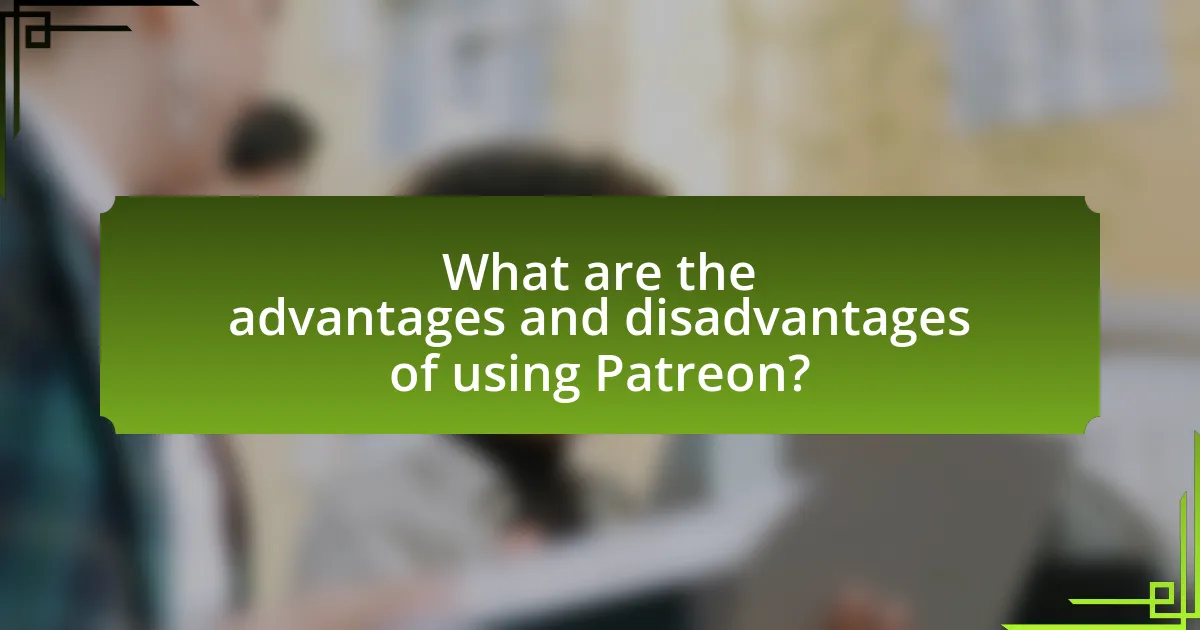
What are the advantages and disadvantages of using Patreon?
Patreon offers several advantages and disadvantages for creators seeking to monetize their content. The primary advantage is the ability to generate recurring revenue through subscription-based support, allowing creators to build a stable income stream. According to Patreon, creators can earn an average of $1,000 per month, which highlights the platform’s potential for financial sustainability. Additionally, Patreon provides tools for community engagement, enabling creators to interact directly with their supporters through exclusive content and rewards.
Conversely, a significant disadvantage of using Patreon is the platform’s fee structure, which can take up to 12% of a creator’s earnings, depending on the plan chosen. This fee can reduce overall income, particularly for creators with lower subscriber counts. Furthermore, creators are responsible for consistently producing content to retain subscribers, which can lead to burnout and pressure to meet expectations. Overall, while Patreon can be a valuable tool for monetization and community building, it also presents challenges related to fees and content demands.
What unique features does Patreon provide for creators?
Patreon provides unique features for creators, including tiered membership options, direct communication with supporters, and exclusive content delivery. The tiered membership system allows creators to offer different levels of access and rewards, catering to various supporter budgets and engagement levels. Direct communication tools enable creators to interact with their patrons through messages and posts, fostering a community atmosphere. Additionally, creators can share exclusive content such as behind-the-scenes material, early access to projects, and special merchandise, enhancing the value of patronage. These features collectively empower creators to monetize their work effectively while building a loyal fanbase.
How does tiered membership benefit creators on Patreon?
Tiered membership benefits creators on Patreon by allowing them to offer different levels of access and rewards to their supporters, which can increase overall revenue. This structure enables creators to cater to a wider audience, as supporters can choose a tier that fits their budget and desired level of engagement. For instance, a creator might offer exclusive content, early access to new projects, or personalized interactions at higher tiers, incentivizing fans to contribute more. According to Patreon’s own data, creators who utilize tiered memberships often see higher average earnings compared to those who do not, as it encourages fans to invest more in their favorite creators.
What challenges do creators face when using Patreon?
Creators face several challenges when using Patreon, including platform fees, content management, and audience engagement. The platform charges a fee ranging from 5% to 12% of creators’ earnings, which can significantly impact their overall revenue. Additionally, creators must consistently produce high-quality content to retain subscribers, leading to potential burnout. Engaging and growing an audience can also be difficult, as creators often need to market their Patreon pages outside of the platform to attract new patrons. These challenges highlight the complexities creators encounter while trying to monetize their work effectively on Patreon.
How does Patreon support creators in terms of analytics and insights?
Patreon supports creators by providing detailed analytics and insights that help them understand their audience and optimize their content strategy. Creators have access to metrics such as subscriber growth, engagement rates, and revenue trends, which enable them to make informed decisions about their offerings. For instance, Patreon’s dashboard displays data on patron demographics and retention rates, allowing creators to tailor their content to better meet the preferences of their audience. This data-driven approach enhances creators’ ability to engage with their supporters effectively and maximize their earning potential on the platform.
What metrics can creators track on Patreon?
Creators on Patreon can track several key metrics, including total earnings, number of patrons, patron retention rate, and engagement metrics such as post views and likes. Total earnings provide insight into financial performance, while the number of patrons indicates the size of the supporter base. The patron retention rate helps assess how well creators maintain their subscribers over time. Engagement metrics, such as post views and likes, offer valuable feedback on content performance and audience interest. These metrics enable creators to make informed decisions about their content strategy and growth on the platform.
How can analytics improve a creator’s strategy on Patreon?
Analytics can significantly enhance a creator’s strategy on Patreon by providing insights into subscriber behavior and content performance. By analyzing metrics such as subscriber growth, engagement rates, and content popularity, creators can identify which types of content resonate most with their audience. For instance, data may reveal that video content generates higher engagement than written posts, prompting creators to focus more on video production. Additionally, understanding subscriber demographics allows creators to tailor their offerings to meet the specific interests and preferences of their audience, ultimately leading to increased retention and revenue. This data-driven approach is supported by studies indicating that creators who leverage analytics can see up to a 30% increase in subscriber retention rates.

What are the advantages and disadvantages of using Substack?
Substack offers several advantages and disadvantages for content creators. The primary advantage is its user-friendly platform that allows writers to monetize their newsletters easily, with a straightforward subscription model that can lead to direct income from subscribers. Additionally, Substack provides built-in audience engagement tools, such as comments and analytics, which help creators understand their readership better. A notable statistic is that Substack has reported over 1 million paid subscribers as of 2021, indicating its growing popularity among writers.
On the downside, Substack has limitations, including a lack of customization options for branding and design compared to other platforms. Furthermore, creators may face challenges with subscriber retention, as the platform’s focus on email newsletters can lead to higher churn rates. Additionally, Substack takes a 10% cut of subscription revenue, which can impact overall earnings for creators.
What makes Substack appealing for writers and journalists?
Substack is appealing for writers and journalists primarily due to its straightforward monetization model and direct relationship with readers. This platform allows creators to easily set up paid subscriptions, enabling them to earn revenue directly from their audience without relying on traditional advertising or intermediaries. According to Substack’s own data, many writers have successfully transitioned to this model, with some earning substantial incomes, which highlights the platform’s effectiveness in supporting independent journalism and writing. Additionally, Substack fosters a community-oriented environment where writers can engage directly with their subscribers, enhancing reader loyalty and feedback.
How does Substack’s simplicity benefit new writers?
Substack’s simplicity benefits new writers by providing an intuitive platform that allows them to focus on content creation rather than technical complexities. This user-friendly interface enables writers to easily set up their newsletters, manage subscriptions, and engage with their audience without needing extensive technical skills. According to a survey by Substack, 90% of new writers reported that the ease of use significantly reduced their barriers to entry, allowing them to publish their work quickly and efficiently.
What limitations might writers encounter on Substack?
Writers on Substack may encounter limitations such as platform dependency, revenue sharing, and audience growth challenges. Substack operates on a subscription model, which means writers must rely on their ability to attract and retain subscribers to generate income. This dependency can hinder revenue stability, especially for those without an established audience. Additionally, Substack takes a 10% cut of subscription revenue, which can impact overall earnings. Furthermore, writers may face difficulties in expanding their reach beyond the Substack ecosystem, as the platform does not inherently promote content, requiring writers to actively market their newsletters to grow their subscriber base.
How does Substack handle subscriber management and payments?
Substack manages subscriber management and payments through an integrated platform that allows creators to easily set up and maintain their subscriber lists while processing payments seamlessly. The platform enables creators to offer free and paid subscriptions, with payment processing handled by Stripe, which facilitates secure transactions and automatic billing for subscribers. Substack provides tools for tracking subscriber engagement, managing email lists, and analyzing subscription metrics, ensuring that creators can effectively communicate with their audience and optimize their content offerings.
What payment options are available for Substack creators?
Substack creators can utilize several payment options, primarily including subscription-based payments and one-time donations. Substack allows creators to set up paid subscriptions where readers can pay a monthly or annual fee for access to exclusive content. Additionally, creators can accept one-time donations through platforms like PayPal or Stripe, providing flexibility for supporters who may not want to commit to a recurring subscription. This payment structure is designed to facilitate direct financial support from readers, enhancing the sustainability of creators’ work.
How does Substack ensure subscriber retention?
Substack ensures subscriber retention by providing creators with tools to engage their audience effectively. These tools include customizable newsletters, direct communication channels, and the ability to offer exclusive content, which fosters a sense of community and belonging among subscribers. Additionally, Substack’s focus on high-quality content encourages creators to maintain consistent publishing schedules, which keeps subscribers engaged and reduces churn. According to a report by Substack, creators who regularly interact with their audience see a significant increase in subscriber loyalty, demonstrating the effectiveness of these engagement strategies.
What factors should you consider when choosing between Patreon and Substack?
When choosing between Patreon and Substack, consider the type of content you create and your monetization strategy. Patreon is designed for creators who produce diverse content types, such as videos, podcasts, and artwork, allowing for tiered membership levels and various engagement options. In contrast, Substack focuses primarily on written content, enabling creators to monetize newsletters through subscriptions.
Additionally, evaluate your audience’s preferences; if they favor interactive content and community engagement, Patreon may be more suitable. Conversely, if your audience prefers in-depth articles and straightforward subscription models, Substack could be the better choice.
Finally, consider the fee structures: Patreon takes a percentage of your earnings, which can vary based on the plan, while Substack typically charges a 10% fee on subscriptions. Understanding these factors will help you make an informed decision based on your content type, audience engagement, and financial considerations.
How do your content goals influence your platform choice?
Content goals significantly influence platform choice by determining the type of engagement and monetization strategies that best align with the creator’s objectives. For instance, if a creator aims to build a community and offer tiered membership benefits, Patreon is often preferred due to its focus on subscription-based models and community interaction features. Conversely, if the goal is to distribute written content and monetize through direct subscriptions to newsletters, Substack is more suitable, as it specializes in email-based content delivery and allows for straightforward monetization of individual newsletters. This alignment between content goals and platform capabilities ensures that creators can effectively reach their target audience and achieve their desired outcomes.
What role does your target audience play in selecting a platform?
The target audience plays a crucial role in selecting a platform by influencing the type of content creators choose to engage with. Understanding the preferences, demographics, and behaviors of the target audience helps creators determine whether Patreon or Substack aligns better with their content strategy. For instance, Patreon is often favored for creators offering tiered memberships and exclusive content, appealing to audiences willing to pay for additional value. In contrast, Substack attracts writers who focus on newsletters and direct communication, catering to audiences interested in consuming written content regularly. This alignment with audience expectations is supported by data indicating that 70% of creators on Patreon report that their audience’s willingness to pay directly impacts their platform choice.
What are some best practices for maximizing success on Patreon or Substack?
To maximize success on Patreon or Substack, creators should focus on building a strong community and consistently delivering high-quality content. Engaging with subscribers through regular updates, personalized messages, and feedback requests fosters loyalty and encourages retention. Additionally, offering tiered membership levels with exclusive benefits can attract a wider audience and increase revenue. According to a study by Patreon, creators who interact with their audience at least once a week see a 20% higher retention rate compared to those who do not engage regularly. This demonstrates that active communication and value-added content are crucial for sustaining growth on these platforms.
